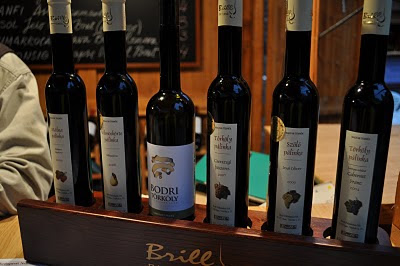

Brill Palinka: http://www.brillpalinkahaz.hu/
The Hungarians quite like their Palinka, no, that's a bit too much of an understatement, the Hungarians love their Palinka. It's almost a national religion, though a pagan one at that, which about as many deities as I've had hot dinners, maybe more.
Anyway, it's a cold and very wet late afternoon at the Buda Castle wine festival, I'm sat with Adrienne from www.vinoport.hu and Marta from Pendits, we've all got bright green fleece rugs over our legs and frankly everyone's enthusiasm is waning. Then Adrienne makes a suggestion, Palinka, just what we need to warm cockles and generally put a happy glow on our faces, and then to go one better, the intruiging prospect of Asparagus Palinka...
Brill, the name sort of suggests what I though of them, though obviously they hadn't realised that it was a common shortened version of brilliant in the UK.
They're based in a town called Hardt in the south of the country near to the wine region Szeksard, where I'm informed that the climate is so Mediterranean that they get cicadas in the evenings. They're family owned and frankly I think they're a bit mad, but they do make good Palinka.
We started with an Irsai Oliver 09, one of the Hungarian indigenous grape varieties, this is similar in aromatics to Muscat and make pleasant low acid wines that need drinking in their first year or so. What Brill look for is extremely ripe or over ripe grapes, the acidity isn't important, but the aroma is. They harvest the grapes very carefully and then crush and distil. The resultant Palinka shows incredibly pure aromatics, very grapey, very floral and extremely clean on the palette.
They also make a Marc of the same variety, for this they purchased the grapes especially with the Marc in mind, apparently they made a wine out of the unneeded juice for friends and family, this might seem excessively devoted to quality, but it's the only way they can ensure they get the grape skins still with the essential 40% of juice remaining. The Marc shows similar aromatics, but much more complexity adding in waxy oily notes, and some lovely herbaceous characters.
Next up was a Marc of Cserszegi Fuszeres (yep that is close to impossible to spell) 07, this was aged in large format Cherry wood and Acacia barrels for 18 months. It was suggested that this would have been perfect with Indian food, given the high alcohol I'm not sure if I'd agree with matching it to Indian savouries, but with desserts it would be a treat. It was fabulously exotically spiced, with white pepper, camphor, clove and fresh lime flavours and an incredible smoothness on the palette, it managed to really hide it's alcohol. What made this most intriguing though was returning to the empty glass and watching how the aroma changed. After about a minute the most fabulous aromas of Bergamot and Earl Grey tea started to appear.
Elderberry 09 was powerful, oily and impressive, oddly coming across as stronger which we put down to weight of flavours it was packing.
Then for the teaser...... 3 tonnes of Asparagus, both white and green, due to the low sugar and high starch contents, they had to use an amylitic enzyme to make the sugars fermentable (similar to germinating barley grains for beer or whisky making), then after all the distillation, 35 litres remained. This was essence of Asparagus, slightly woody but very full flavoured and my word did it last on the palette.
Then to finish Bears Garlic http://www.uni-graz.at/~katzer/engl/Alli_urs.html , a herb I wasn't initially familiar with, but one smell took me right back to one of the herbal supplements we used to feel my horse, it's wild garlic and it has the most intriguingly earthy, garlicy, meaty nose. Apparently it's very trendy in German and Hungarian cooking at the moment and Brill decided to make a long maceration in apple Palinka to show off its flavour. Which they do very well. Though I'm not sure it'd be my go to Palinka to have after dinner it was certainly fascinating.

No comments:
Post a Comment